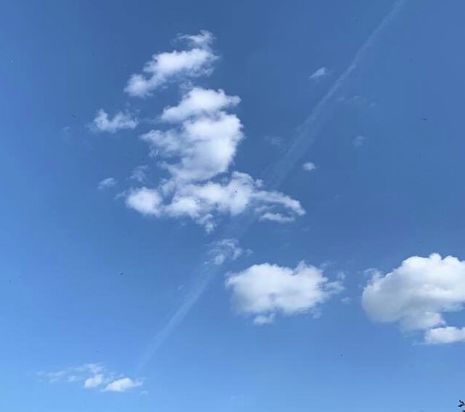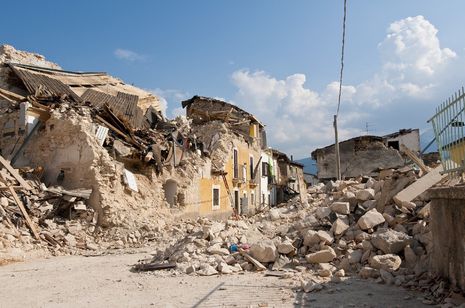Cloudy with a chance of…earthquakes?
Discussing the science behind the shape of clouds, Eloise Matthews describes a debated theory of whether clouds may help predict earthquakes.

Transient yet mighty, clouds have both scientific and psychological significance. We commonly hear that we are made of stardust, with elements being reconfigured throughout the universe over incomprehensible timescales. On a much smaller scale, both spatially and temporally, we are physically connected with clouds via the water cycle: our own evaporated beads of sweat could later condensate into a cloud.
“Our connection with clouds is also arguably emotional. This could stem from the phenomenon pareidolia, where humans tend to spot shapes and patterns in everyday objects.”
Our connection with clouds is also arguably emotional. This could stem from the phenomenon pareidolia, where humans tend to spot shapes and patterns in everyday objects. The most well-known example of this is seeing the Man in the Moon, where darker regions on the surface of the moon, known as lunar seas, appear to form a face. Being so variable in their appearance, spotting recognisable shapes in clouds is very common, but different people may certainly interpret one cloud in a different way. The cover picture shows a cloud formation I spotted a few months ago which I thought looked like the UK.
Interestingly, at least in my opinion, the categorisation of clouds is comparable to phylogenetic taxonomy, the classification of organisms. This is based on the taxonomic system developed by Carolus Linnaeus, from kingdom down to species. Clouds are identified by genus most commonly, of which there are ten. These genera are then broken down into species, then with additional varieties and supplementary features leading to innumerable combinations.
For example, cirrus uncinus vertebratus mamma clouds would be high altitude feathery wisps of ice crystals, comma or hook shaped, arranged in a long column with small protrusions on their undersides. Like many words in English, terms for clouds derive from Latin - for example, “stratus” means layer, “cumulus” denotes heaps, “alto” indicates height, and so forth. More variations in cloud types can be explored online.
Clouds are responsible for much of the uncertainty in future climate projections, since they both absorb and reflect the infrared radiation responsible for warming our planet. Water vapour is an absorptive greenhouse gas; resultant warming enables more cloud formation as more air will be heated and rise to a suitable altitude to form clouds. These can then absorb more radiation, leading to a positive feedback loop. However, increased cloud formation also results in negative feedback as the reflectivity of clouds’ upper white surfaces, known as their albedo, reduces incoming solar radiation hence actually having a cooling effect. The balance of these two feedbacks is uncertain, and could therefore affect our long-term climate stability.
“An initially far-fetched and dismissed proposal, retired chemist Zhonghao Shou’s claim that earthquakes can be predicted from the appearance of specific types of cloud has been gaining more evidence and interest in recent years.”
The short-term safety of human civilisations could also be linked to clouds, regarding natural disasters, hence the title of this article. An initially far-fetched and dismissed proposal, retired chemist Zhonghao Shou’s claim that earthquakes can be predicted from the appearance of specific types of cloud has been gaining more evidence and interest in recent years. Other scientists around the world, such as the Russian Morozova, had previously considered the geological significance of these unusual clouds, but Shou was the first to propose a theory and devote significant time to their study and associated earthquake prediction. We firstly must make sure we take the term “predict” with a large pinch of salt, as it could never be precisely pinpointed when the pressure building along a fault, a crack in the Earth’s crust, will be released, which triggers an earthquake. The current most popular method for earthquake forecasting is from seismographs, where the relative motion of the ground is recorded. Earthquake data is also beginning to be considered for monitoring ocean warming, another tie in to climate studies.

Shou’s unconventional theory is as follows: intense heat and pressure at faults, due to friction between sections of crust, enables underground water vapour to collect in cracks around larger faults. These can be released to the surface, where the amount of vapour can indicate the strength, and thus magnitude, of the impending earthquake. Once the vapour is released from the fault, which signals roughly where the epicentre will be, it heats up the surrounding air. This enables it to rise, and, once at a suitable altitude (as is the standard procedure for cloud formation), cool and condense - forming clouds roughly along the fault line, fuelled from the point of vapour release. This release is accompanied by a drop in strength of the surrounding rock, hence making an earthquake likely.
“Shou’s method is claimed to have 60% accuracy in all three windows of prediction, and an average lead time of 30 days, proving great potential.”
Interest began to spark after Shou’s seemingly incredibly accurate prediction of an earthquake that occurred in Bam, Iran, on Boxing Day in 2003. Just the day before, Shou identified a “classic” earthquake cloud, from satellite images, running above a fault in Iran and predicted that an earthquake with magnitude greater than 5.5 would occur there within 60 days from its formation on 20th December - and sure enough, after some foreshocks on Christmas day, an earthquake measuring 6.6 on the Richter scale tore through Bam on the 26th, claiming 26,000 lives. The surface temperature at the nearby Kerman Airport increased from 12 to 24 degrees Celsius on the first day of cloud formation, one of the signals of earthquake vapour release.
Shou has even written a book about his ideas, Earthquake Vapor Model and Precise Prediction, first published in 2016. Other seismologists have begun to probe the validity of this forecasting method, but much skepticism still surrounds the topic. For example, while studies such as one by Thomas, Masci, & Love find no statistically significant relationship between cloud formation and earthquakes, Morozova’s work appears supportive of the method when used in conjunction with other forecasting techniques.
It brings into question the worth of such investigations into the role of clouds; for example, would money not be better spent on improving the earthquake resistance of buildings in high risk areas? I would argue yes, in the long run. The earthquakes will happen regardless of whether we forecast them or not, so protecting the livelihoods of the people at risk should surely be the priority. However, predictions would enable evacuations, perhaps saving more lives in the first place. Shou’s method is claimed to have 60% accuracy in all three windows of prediction, and an average lead time of 30 days, proving great potential.
Even Pliny the Elder, well known Roman polymath, appears to have alluded to the existence of earthquake clouds in his works Historia Naturalis: “There is also a sign [of earthquakes] in the heavens; for, when a shock is near at hand, either in the daytime or a little after sunset, a cloud is stretched out in the clear sky, like a long thin line.” This aligns with Shou’s idea of narrow streaks of cloud above a fault signifying an impending earthquake. With at least almost two millennia’s worth of note, perhaps now that we have the enabling technology, we should pursue this phenomenon of “earthquake clouds”. Earthquake prediction has always been hazy, so short-term pinpointing techniques may arguably be the most useful for saving lives, and coupled with mitigating damage, will strengthen the resilience of vulnerable societies.
 Comment / Plastic pubs: the problem with Cambridge alehouses 5 January 2026
Comment / Plastic pubs: the problem with Cambridge alehouses 5 January 2026 News / Cambridge academics stand out in King’s 2026 Honours List2 January 2026
News / Cambridge academics stand out in King’s 2026 Honours List2 January 2026 News / Cambridge businesses concerned infrastructure delays will hurt growth5 January 2026
News / Cambridge businesses concerned infrastructure delays will hurt growth5 January 2026 News / AstraZeneca sues for £32 million over faulty construction at Cambridge Campus31 December 2025
News / AstraZeneca sues for £32 million over faulty construction at Cambridge Campus31 December 2025 Interviews / You don’t need to peak at Cambridge, says Robin Harding31 December 2025
Interviews / You don’t need to peak at Cambridge, says Robin Harding31 December 2025









